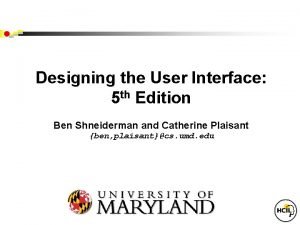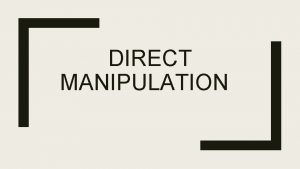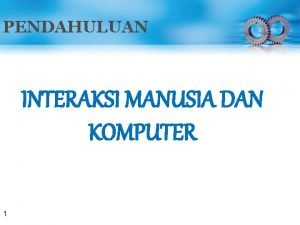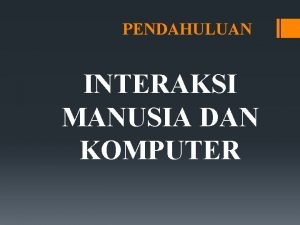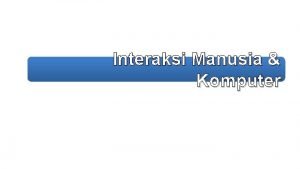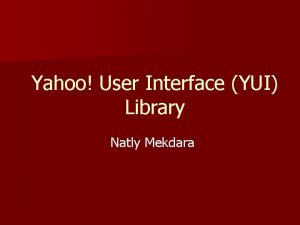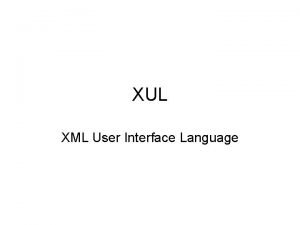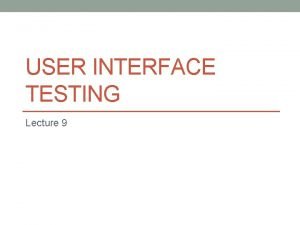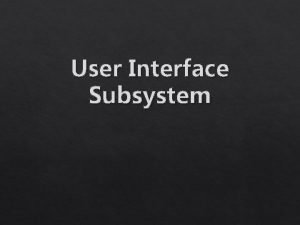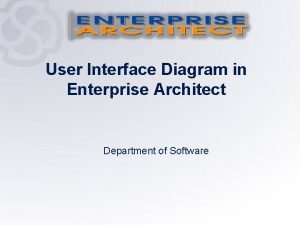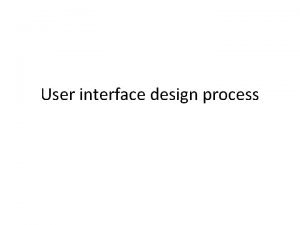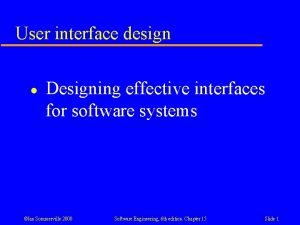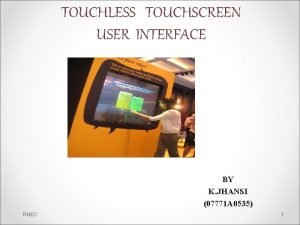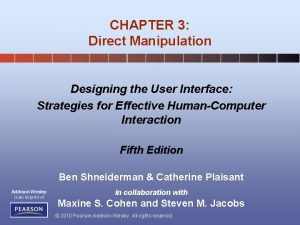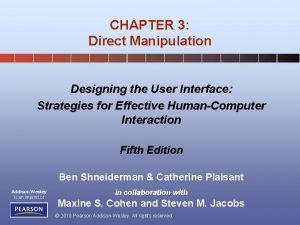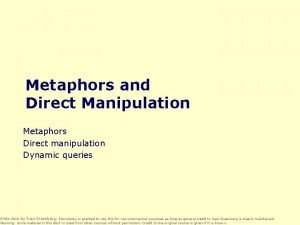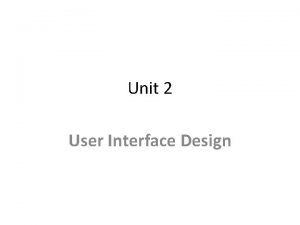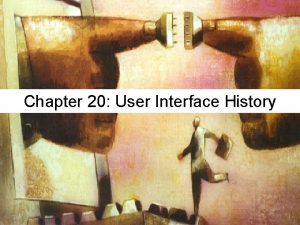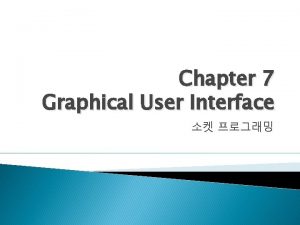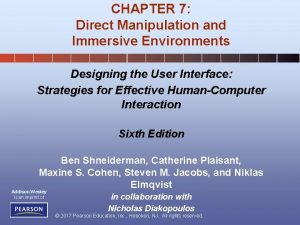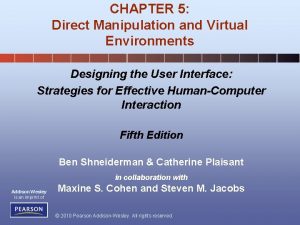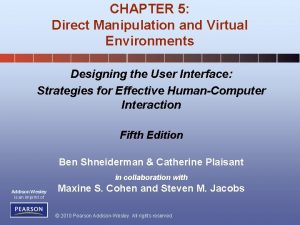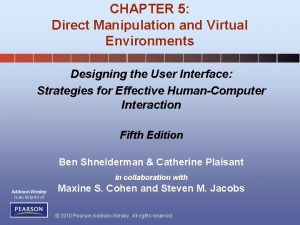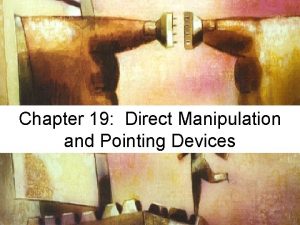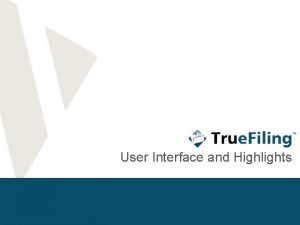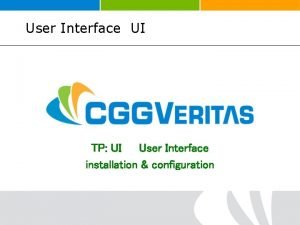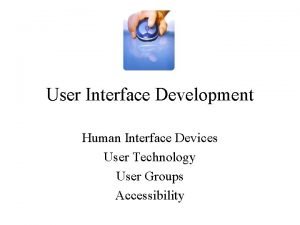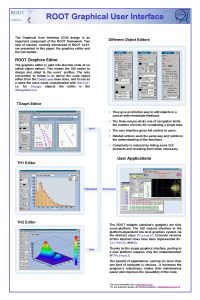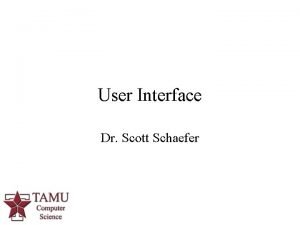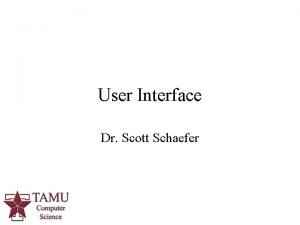CHAPTER 3 Direct Manipulation Designing the User Interface























- Slides: 23

CHAPTER 3: Direct Manipulation Designing the User Interface: Strategies for Effective Human-Computer Interaction Fifth Edition Ben Shneiderman & Catherine Plaisant Addison Wesley is an imprint of in collaboration with Maxine S. Cohen and Steven M. Jacobs © 2010 Pearson Addison-Wesley. All rights reserved.


Introduction • Newer concepts extend direct manipulation Include – Collaborative interfaces – Touchable interfaces – Virtual reality – Augmented reality – Teleportation ﺍﻟﻤﺒﺎﺷﺮﺗﺘﻀﻤﻦ ﺍﻟﺘﻼﻋﺐ ﺗﻤﺘﺪ ﺍﻷﺤﺪﺙ ﺍﻟﻤﻔﺎﻫﻴﻢ ﺍﻟﺘﻌﺎﻭﻧﻴﺔ ﺍﻟﻮﺍﺟﻬﺎﺕ ﻟﻠﻤﺲ ﻗﺎﺑﻠﺔ ﻭﺍﺟﻬﺎﺕ ﺍﻻﻓﺘﺮﺍﺿﻲ ﺍﻟﻮﺍﻗﻊ ﺍﻟﻤﻌﺰﺯ ﺍﻟﻮﺍﻗﻊ ﺗﻴﻠﻴﺒﻮﺭﺗﺎﺗﻴﻮﻥ 1 -3 © 2010 Pearson Addison-Wesley. All rights reserved. 6 -3


Direct-Manipulation Systems : Spatial data management • In geographic applications, it seems natural to give a spatial representation in the form of a map that provides a familiar model of reality. • Xeroc PARC’s Information Visualizer : Tools for three-dimensional animated explorations of buildings, cone-shaped file directories, organization charts, a perspective wall that puts f atured items up front and centered, and several two- and three-dimensional information layouts. • Arc. GIS™ by ESRI™is a widely used geographic-information system (GIS) that offers rich, layered databases of map-related information • Google. Maps™and the more powerful Google Earth™ combines geographic information from aerial photographs, satellite imagery, and other sources to create a database of graphical information that can easily be viewed and displayed. © 2010 Pearson Addison-Wesley. All rights reserved. 1 -5 6 -5



Direct-Manipulation Systems : Computer-aided design • Most computer-aided design (CAD) systems for automobiles, electronic circuitry, aircraft, or mechanical engineering use principles of direct manipulation. • Building and home architects now have at their disposal powerful tools, such as Autodesk Inventor with components to handle structural engineering, floor plans, interiors, landscaping, plumbing, electrical installation, and much more. • There are large manufacturing companies using Auto. CAD® and similar systems, but there also other specialized design programs for kitchen and bathroom layouts, landscaping plans, and other homeowner-type situations. • Related applications are for computer-aided manufacturing (CAM) and process control. Honeywell's Experion® Process Knowledge System provides the manager of an oil refinery, paper mill, or powerutility plant with a colored schematic view of the plant. 1 -8 © 2010 Pearson Addison-Wesley. All rights reserved. 6 -8



3 D Interfaces 1 -11 © 2010 Pearson Addison-Wesley. All rights reserved. 6 -11

3 D Interfaces • Some designers dream about building interfaces that approach the richness of three-dimensional reality. • Closer the interfaces to the real world, will be easier to use. • For some computer-based tasks—such as medical imagery, architectural drawing, computer-assisted design, chemical-structure modeling, and scientific simulations—pure 3 D representations are clearly helpful and have become major industries. • Successful applications of 3 D representations are game environments • Some web-based game environments, such as Second Life, may involve millions of users and thousands of user-constructed "worlds, " such as schools, shopping malls, or urban neighborhoods. • Three-dimensional art and entertainment experiences, often delivered by web applications, provide another opportunity for innovative applications. 1 -12 © 2010 Pearson Addison-Wesley. All rights reserved. 6 -12



Teleoperation - Applications • Telemedicine: o Medical care delivered over communication links o Allows physicians to examine patients remotely and surgeons to carry out operations across continents. • Telepathology o A pathologist examines tissue samples or body fluids under a remotely located microscope. o The transmitting workstation has a high resolution camera mounted on a motorized light microscope. o The pathologist at the receiving workstation can manipulate the microscope using a mouse or keyboard and can see a high resolution image of magnified sample. 1 -15 © 2010 Pearson Addison-Wesley. All rights reserved. 6 -15


Telepathology 1 -17 © 2010 Pearson Addison-Wesley. All rights reserved. 6 -17


Robotic surgery 1 -19 © 2010 Pearson Addison-Wesley. All rights reserved. 6 -19


Teleoperation Complicating factors in the architecture of remote environments: – Time delays • transmission delays • operation delays – Incomplete feedback – Feedback from multiple sources – Unanticipated interferences : ﺗﻴﻠﻴﻮﺑﻴﺮﺍﺗﻴﻮﻥ : ﺍﻟﻨﺎﺋﻴﺔ ﺍﻟﺒﻴﺌﺎﺕ ﺑﻨﻴﺔ ﻓﻲ ﺍﻟﻤﻀﺎﻋﻔﺔ ﻟﻌﻮﺍﻣﻞ ﺍﻟﻮﻗﺖ ﺗﺄﺨﻴﺮ ﺍﻹﺭﺳﺎﻝ ﺗﺄﺨﺮ ﺍﻟﺘﺸﻐﻴﻞ ﺗﺄﺨﻴﺮﺍﺕ ﻣﻜﺘﻤﻠﺔ ﻏﻴﺮ ﻣﻼﺣﻈﺎﺕ ﻣﺘﻌﺪﺩﺓ ﻣﺼﺎﺩﺭ ﻣﻦ ﺗﻌﻠﻴﻘﺎﺕ ﻣﺘﻮﻗﻌﺔ ﻏﻴﺮ ﺗﺪﺧﻼﺕ - 1 -21 © 2010 Pearson Addison-Wesley. All rights reserved. 6 -21

Direct Manipulation – Benefits and Drawbacks Benefits: • Control/display compatibility • Less syntax reduces error rates • Errors are more preventable • Faster Learning and higher retention • Encourages exploration Drawbacks: • Increased system resources • Some action may be cumbersome • Macro techniques are often weak • History and other tracing may be difficult • Visually impaired users may have more difficulty 1 -22 © 2010 Pearson Addison-Wesley. All rights reserved. 6 -22

 Ben shneiderman designing the user interface
Ben shneiderman designing the user interface Direct manipulation interface
Direct manipulation interface What is interface in java
What is interface in java Abowd and beale framework example
Abowd and beale framework example Office interface vs industrial interface
Office interface vs industrial interface An interface
An interface Direct manipulation principles
Direct manipulation principles Pengertian direct manipulation
Pengertian direct manipulation Latar belakang imk
Latar belakang imk Gaya dialog menu
Gaya dialog menu Yahoo user interface
Yahoo user interface What is xul
What is xul Graphical user interface testing
Graphical user interface testing User interface subsystem
User interface subsystem Component diagram enterprise architect
Component diagram enterprise architect Basic principles of input design
Basic principles of input design User interface design cycle
User interface design cycle The importance of user interface
The importance of user interface User interface in software engineering
User interface in software engineering User interface analysis and design
User interface analysis and design Touchless touchscreen user interface
Touchless touchscreen user interface Characteristics of graphical user interface
Characteristics of graphical user interface Principles of user interface design
Principles of user interface design Interactible
Interactible
